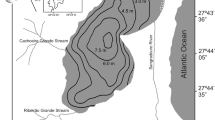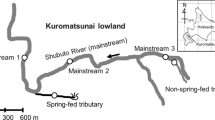Abstract
The macroinvertebrate fauna of five karst (limestone) springbrook systems with contrasting physical habitat and discharge patterns were investigated to examine the role of flow permanence and habitat structure on macroinvertebrate community composition. Clear physical differences were identified between perennial and intermittent springs and individual sampling stations. However, flow permanence, water temperature and the input of leaf litter exerted a greater influence on the aquatic invertebrate community than habitat structure. Perennial sites were characterised by a greater abundance of macroinvertebrates and greater Ephemeroptera, Plecoptera and Trichoptera (EPT) richness than intermittent sites. The fauna of all of the springbrook systems examined were dominated by relatively common and ubiquitous taxa (e.g. Gammarus pulex) although a number of taxa displaying life cycle adaptations to ephemeral aquatic habitats (e.g. Limnephilus auricula and Stenophylax permistus) were recorded at intermittent sites.
Similar content being viewed by others
References
Armitage, P. D., I. Pardo & A. Brown, 1995. Temporal constancy in 'mesohabitats' - application to management. Arch. Hydrobiol. 133: 367-387.
Arscott, D. B., K. Tockner & J. V. Ward, 2001. Thermal heterogeneity along a braided floodplain river (Tagliamento River, northeastern Italy). Can. J. Fish. aquat. Sci. 58: 2359-2373.
Batzer, D. P. & V. H. Resh, 1992. Macroinvertebrates of a California seasonal wetland and responses to experimental habitat manipulation. Wetlands 12: 1-7.
Botosaneanu, L., 1998. Studies in Crenobiology: The Biology of Springs and Springbrooks. Backhuys Publishers, Leiden: 261 pp.
Boulton, A. J., 1989. Over-summering refuges of aquatic macroinvertebrates in two intermittent streams in Central Victoria. Trans. r. Soc. Southern Aust. 113: 23-34.
Boulton, A. J. & P. S. Lake, 1992. The ecology of two intermittent streams in Victoria, Australia. II. Comparisons of faunal composition between habitats, rivers and years. Freshwat. Biol. 27: 99-121.
Castella, E., M. Bickerton, P. D. Armitage & G. E. Petts, 1995. The effects of water abstractions on invertebrate communities in U.K. streams. Hydrobiologia 308: 167-182.
Danks, H. V. & D. D. Williams, 1991. Arthropods of springs, with particular reference to Canada: synthesis and needs for research. Mem. Entomol. Soc. Can. 155: 203-217.
Erman, N. A. & D. C. Erman, 1995. Spring Permanence, Trichoptera Species Richness, and the Role of Drought. J. Kans. Entomol. Soc. 68: 50-64.
Feminella, J. W., 1996. Comparison of benthic macroinvertebrate assemblages in small streams along a gradient of flow permanence. J. N. am. benthol. Soc. 15: 651-669.
Glazier D. S., 1991. The fauna of North American temperate cold springs: patterns and hypotheses. Freshwat. Biol. 26: 527-542.
Glazier, D. S. & J. L. Gooch, 1987. Macroinvertebrate assemblages in Pennsylvania (U.S.A.) springs. Hydrobiologia 150: 33-43.
Gooch, J. L. & D. S. Glazier, 1991. Temporal and spatial patterns in mid-Appalachian springs. Mem. Entomol. Soc. Can. 155: 29-49.
Gordon, N. D., T. A. McMahon & B. L. Finlayson, 1992. Stream Hydrology: An Introduction for Ecologists. John Wiley and Sons, Chichester: 526 pp.
Gray, L. J., 1981. Species composition and life histories of aquatic insects in a lowland Sonoran desert stream. Am. Mid. Nat. 106: 229-242.
Gunn, J., D. Lowe & T. Waltham, 1998. The karst geomorphology and hydrogeology of Great Britain. In Daoxian, Y. & L. Zaihua (eds), Global Karst Correlation. Science Press and VSP BV.
Harper, D. M., C. Smith, P. Barham & R. Howell, 1995. The ecological basis for the management of the natural environment. InHarper, D. M. & A. J. Ferguson (eds), The Ecological Basis for River Management. John Wiley and Sons, Chichester: 59-78.
Hoffsten, P.-O. & B. Malmqvist, 2000. The macroinvertebrate fauna and hydrogeology of springs in central Sweden. Hydrobiologia 436: 91-104.
Ito, T., 1998. The biology of the primitive, distinctly crenophilic caddisflies, Ptilocolepinae (Trichoptera, Hydroptilidae). A review. In Botosaneanu, L. (ed.), Studies in Crenobiology: The Biology of Springs and Springbrooks. Backhuys Publishers, Leiden: 85-94.
Ladle, M. & J. A. B. Bass, 1981. The ecology of a small chalk stream and its responses to drying during drought conditions. Arch. Hydrobiol. 90: 448-466.
Langton, P. H. & J. Cass, 1998. Changes in chironomid assemblage composition in two Mediterranean mountain streams over a period of extreme hydrological conditions. Hydrobiologia 390: 37-47.
Lindegaard, C., 1995. Chironomidae (Diptera) of European cold springs and factors influencing their distribution. J. Kans. Entomol. Soc. suppl. 68: 108-131.
Lindegaard, C., K. P. Brodersen, P. Wiberg-Larsen & J. Skriver, 1998. Multivariate analyses of macrofaunal communities in Danish springs and springbrooks. In Botosaneanu, L. (ed.), Studies in Crenobiology: The Biology of Springs and Springbrooks. Backhuys Publishers, Leiden: 201-210.
Meyer, A. & E. I. Meyer, 2000. Discharge and macroinvertebrates in a temporary karstic stream. Aquat. Sci. 62: 216-231.
Pardo, I. & P. D. Armitage, 1997. Species assemblages as descriptors of mesohabitats. Hydrobiologia 344: 111-128.
Petts, G. E., M. A. Bickerton, C. Crawford, D. N. Learner & D. Evans, 1999. Flow management to sustain groundwaterdominated stream ecosystems. Hydrol. Process. 13: 497-513.
Pisces Conservation, 1998. α Species Diversity and Richness. Pisces Conservation Ltd, Lymington, Hampshire.
Pitty, A. F., 1976. Water temperatures of the limestone areas of the central and southern Pennines. Proc. Yorkshire Geol. Soc. 40: 601-612.
Ponder, W. F., 1985. South Australian mound springs: relict faunas in the desert. Aust. Nat. Hist. 21: 352-355.
Rosi-Marshall, E. J. & J. B. Wallace, 2002. Invertebrate food webs along a stream resource gradient. Freshwat. Biol. 47: 129-141.
Ryen, M. & J. Meiman, 1996. An examination of short-term variations in water quality in a karst spring in Kentucky. Groundwater 34: 23-30.
Smith, H., 2000.The hydro-ecology of limestone springs in the Wye Valley, Derbyshire. Unpublished PhD thesis, University of Huddersfield.
Smith, H., J. Gunn & P. J. Wood, 2001. The macroinvertebrate communities of limestone springs of theWye Valley Derbyshire. Cave and Karst Sci. 28: 67-78.
Smith, H. & P. J. Wood, 2002. Flow permanence and macroinvertebrate community variability in limestone spring systems. Hydrobiologia 487: 45-58.
Sommerhäuser, M., B. Robert & H. Schuhmacher, 1996. Flight periods and life strategies of caddisflies in temporary and perennial woodland brooks in the Lower Rhine Area (Germany). Proceedings of the Eighth International Symposium on Trichoptera, Minneapolis/St Paul, July 1995: 425-433.
ter Braak, C. J. F. & P. Šmilauer, 1998. CANOCO Reference Manual and User's Guide to Canoco for Windows: Software for Canonical Community Ordination (version 4). Microcomputer Power, Ithaca, NY, U.S.A.: 352 pp.
Townsend, C. R., A. G. Hildrew & K. Schofield, 1987. Persistence of stream communities in relation to environmental variability.J. anim. Ecol. 56: 597-613.
van der Kamp, G., 1995. The hydrogeology of springs in relation to the biodiversity of spring fauna: a review. J. Kans. Entomol. Soc. Suppl. 68: 4-17.
Webb, D. W., M. J. Wetzel, P. C. Reed, L. R. Phillippe & T. C. Young, 1998. The macroinvertebrate biodiversity, water quality, and hydrogeology of ten karst springs in the Salem Plateau Section of Illinois, U.S.A. In Botosaneanu, L. (ed.), Studies in Crenobiology: The Biology of Springs and Springbrooks. Backhuys Publishers, Leiden: 39-48.
Wiggins, G. B.,R. J. Mackay & I. M. Smith, 1980. Evolutionary and ecological strategies of animals in annual temporary pools. Arch. Hydrobiol. suppl. 58: 97-206.
Williams, D. D., 1991. The spring as an interface between groundwater and lotic faunas and as a tool in assessing groundwater quality. Verh. int. Ver. Theor. Angew. Limnol. 24: 1621-1624.
Williams, D. D., 1996. Environmental constraints in temporary fresh waters and their consequences for the insect fauna. J. N. am. benthol. Soc. 15: 634-650.
Williams, D. D. & N. E. Williams, 1993. The upstream/downstream movement paradox of lotic invertebrates: quantitative evidence from a Welsh mountain stream. Freshwat. Biol. 30: 199-218.
Williams, D. D. & N. E. Williams, 1998. Invertebrate communities from freshwater springs: what can they contribute to pure and applied ecology? In Botosaneanu, L. (ed.), Studies in Creno-biology: The Biology of Springs and Springbrooks. Backhuys Publishers, Leiden: 251-261.
Williams, D. D. & N. E. Williams, 1999. Canadian Springs: postglacial development of the invertebrate fauna. In Batzer, D. P., R. Rader & S. A. Wissinger (eds), Invertebrates in Freshwater Wetlands of North America: Ecology and Management. John Wiley and Sons, New York: 447-467.
Williams, D. D., N. E. Williams & Y. Cao, 1997. Spatial differences in macroinvertebrate community structure in southeastern Ontario in relation to their chemical and physical environments. Can. J. Zool. 75: 1404-1414.
Williams, D. D., N. E. Williams & Y. Cao, 2000. Road salt contamination of groundwater in a major metropolitan area and development of a biological index to monitor its impact. Water Res. 34: 127-138.
Wood P. J. & P. D. Armitage, 1999. Sediment deposition in a small lowland stream - management implications. Regul. Rivers: Res. Manage. 15: 199-210.
Wood, P. J., D.M. Hannah, M. D. Agnew & G. E. Petts, 2001. Scales of hydroecological variability within a groundwater-dominated stream. Regul. Rivers: Res. Manage. 17: 347-367.
Zollhöfer, J. M., 1999. Spring biotopes in Northern Switzerland: Habitat Heterogeneity, Zoobenthic Communities and Colonization Dynamics. PhD Thesis, Swiss Federal Institute of Science and Technology, Zürich.
Author information
Authors and Affiliations
Rights and permissions
About this article
Cite this article
Smith, H., Wood, P. & Gunn, J. The influence of habitat structure and flow permanence on invertebrate communities in karst spring systems. Hydrobiologia 510, 53–66 (2003). https://doi.org/10.1023/B:HYDR.0000008501.55798.20
Issue Date:
DOI: https://doi.org/10.1023/B:HYDR.0000008501.55798.20




